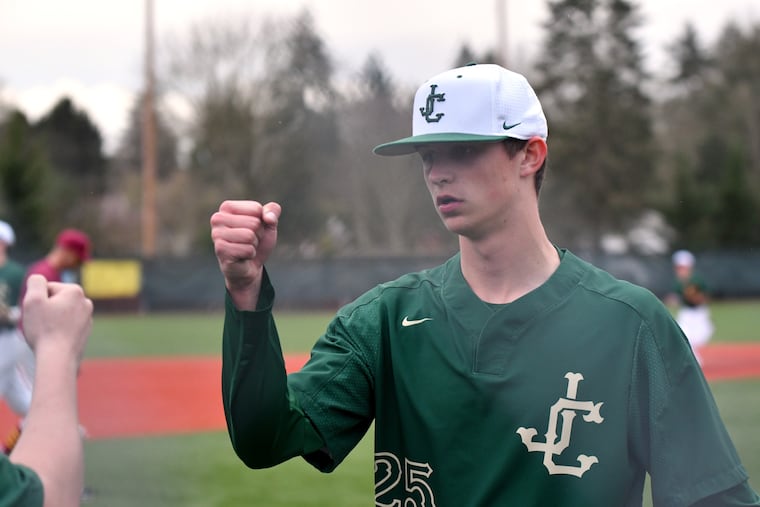Phillies selection of high school pitcher Mick Abel means we’ll have to wait a while to see him | Bob Brookover
First-year Phillies scouting director Brian Barber had an unenviable task running his initial draft during a pandemic, and he made a daring pick by selecting a high school pitcher.

Empathy wasn’t what Brian Barber was searching for Wednesday night as he conducted his first draft as a scouting director for the Phillies. He got it anyway from the man who once held his job.
“Oh, man, I can’t fathom being a first-year scouting director and you’ve never run a draft and you walk into this mess,” said Mike Arbuckle, who spent a decade running the Phillies’ draft room when the team was building a ball club that eventually won the World Series. “You haven’t been able to see a lot of the players, you’re trying to look at video and you haven’t been able to get into a room with your cross-checkers, which is the place where you can tell by the tone of their voice and the expression on their faces about how bad they want a player. It’s just not the same through Zoom meetings and phone calls.”
But that’s the nasty pitch baseball threw at Barber and the former New York Yankees national cross-checker embraced it, stepped up to the plate and made a high school pitcher his initial first-round pick.
It wasn’t the local kid Nick Bitsko from Central Bucks East High School. It was Mick Abel, a 6-foot-5 righthander from Jesuit High School in Portland, Ore. High school pitchers are always a high risk and that’s especially true this year because they were all sidelined by the COVID-19 pandemic.
The good news for Barber is that it’s going to take a while to figure out if his first pick is a hit or a miss. That, of course, is the case even in the most ideal of situations.
Right now, all we can do is speculate about Abel, who unquestionably has the arm to make it to the big leagues.
“There’s definitely more risk associated with a high school pitcher,” Barber admitted during a conference call with reporters. “You’re talking about some formative years where they become an adult man and they have to pitch the innings. That’s probably the biggest risk factor — maintaining the health with those players.”
A rival scout who saw Abel pitch a lot described the 18-year-old as throwing “easy and loose” and said he has a “high ceiling.”
The same scout also has a ton of confidence in Barber.
“He’s outstanding and he will do a great job,” the scout said.
In the NFL, they say it takes at least three years to grade a draft class. In baseball, it takes even longer. The jury, for example, is still out on Barber’s predecessor. Johnny Almaraz conducted five drafts for the Phillies and we’ll probably never know exactly how much influence general manager Matt Klentak and the analytics department had on his final decisions.
We do know that his first two drafts do not look very good at the moment. Only two players — Scott Kingery and Cole Irvin — have graduated to the big leagues from the combined 2015 and 2016 classes. Only the Chicago Cubs have had fewer players reach the big leagues from those two classes.
Cornelius Randolph, the 10th overall pick in 2015, just turned 23 this month, but based on performance his time is running out to reach the big leagues in Philadelphia.
Kingery is really the only thing that can save the 2015 draft from being a complete bust for the Phillies. This was the year we were going to find out if playing second base would allow Kingery to reach his offensive potential, and commissioner Rob Manfred promised before the draft started that we will have a season in some way shape and form. If Kingery emerges as a second baseman who can consistently hit 20 to 30 home runs, the Phillies can live with Randolph being a bust.
Nobody remembers that they took Roy Thomas in the first round of the 1971 draft because they took Mike Schmidt in the second round. And it’s OK that they picked Adam Eaton in the first round of the 1996 draft because they got Jimmy Rollins in the second.
Almaraz and the Phillies tried to play the money game in the 2016 draft and took Mickey Moniak first overall in order to sign high school pitcher Kevin Goudy in the second round and high school shortstop Cole Stobbe in the third round. They may have ended up with three guys who never make it to the big leagues, and it’s unlikely that Cole Irvin will make us forget about that.
Outfielder Adam Haseley, the eighth overall pick in 2017, was one of the first from his draft class to reach the big leagues last season and he provided some hope with the way he hit and played the outfield. If he becomes an everyday player and second-round pick Spencer Howard becomes a top-of-the-rotation starter that class will be remembered fondly.
Third baseman Alec Bohm, third overall in 2018, could have an impact on this pandemic-shortened season, and Bryce Harper’s Vegas buddy Bryson Stott, 14th overall last year, might not be far behind.
Now, Mick Abel is on the clock. As a high school pitcher, however, it’s probably going to be a while before his time arrives.